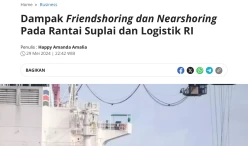Event & News
Lean & Resilience
There has been much commentary about global supply chains not being resilient enough. All the disruptions caused by the pandemic, of course, has contributed to this. One culprit, it is argued, is global supply chains being too lean. Does this mean, companies should abandon lean practices? No. It is possible to be lean, where it makes sense, and resilient.
The Advantages of Lean.
The operational excellence methodology known as “lean” is centered on preserving value with less work by avoiding waste. Lean speaks of the seven wastes: overproduction, unnecessary transportation, inventory, motion, defects, over processing, and waiting. Lean practitioners believe that when manufacturers stockpile large quantities of raw materials, load up the shop floor with work-in-process, and pack warehouses with finished goods, that the results are more product defects, long and unpredictable lead times, higher costs, and too much cash tide up as working capital.
Lean initially became a popular continuous improvement methodology because of Toyota’s emergence as a leader in the automotive industry. Toyota’s success was attributed in large part to their use of lean. The principles of lean were introduced in the book The Machine That Changed the World. The book was published in 1991. Since then, manufacturers around the world have embraced lean.
In the automotive industry, Kanban warehouses are common. These warehouses are located in close proximity to an OEM’s plant. Tier 1 suppliers are engaged in a collaborative forecasting process with the OEM. They supply inventory to support the next week or two of a plant’s production schedule. Inventory is shuttled from the warehouse to the plant on a just-in-time, just-in-sequence basis. This allows the plant to operate in a very lean manner. This practice, known as vendor managed inventory, is an excellent example of lean.
When Should Inventory be “Fat”?
If disruptions to a global supply chain occur, this can result in a company being unable to meet demand. The global semiconductor shortage, that began in the first quarter of this year, has led major carmakers to announce significant rollbacks in their production. It has forced some to tell Wall Street to expect lower revenues. If automakers had foreseen this shortage and stockpiled semiconductor chips, they would be in far better shape.
Does this make the vendor managed inventory process obsolete? It does not. It does mean that manufacturers need to understand where inventory needs to be buffered (“fat”) and where it can remain lean.
This in turn means that manufacturers need to understand where they are single sourced on key components. In terms of single sourcing, a useful metric is called “revenue at risk.” This metric has a manufacturer do an analysis of how much revenue they would lose if a key component became unavailable for some defined period (a week, a month, or even longer).
When it comes to material availability, companies need to look deeply into their supply base. They can’t just have good knowledge of their Tier 1 suppliers and trust them to manage Tier 2. A single sourced component might become unavailable not because of something that the Tier 1 supplier does, but because they are facing shortages from one of their suppliers.
But the semiconductor shortage impacting the auto industry shows that achieving resilience is more complex than having multiple suppliers. According to Bindiya Vikal, CEO of Resilinc, the semiconductor shortage was a long time in the making. Two big Japanese semiconductors had fires last year, a labor strike affected facilities in Europe, and container shortages and groundings of 747s made it difficult to move chips to auto plants. Resilinc is one provider of risk monitoring solutions that maps a company’s end-to-end supply chain. This risk solution understands which plants are supplying a manufacturer, how goods flow to a manufacturer’s plant, and whether there are choke points – like a port – that a high proportion of raw materials flow through.
The Resilinc solution is one type of supply chain collaboration network (SCCN) solution.
Recently published market research shows that this market has been growing rapidly. In part, this is because some SCCN solutions can provide the kind of robust upstream visibility manufacturers need. When the type of analysis provided by SCCN risk solutions is combined with supply chain design tools, like the solution offered by Coupa, companies can understand where inventory buffers need to be located and how much inventory it makes sense to hold at these buffer sites.
Source: https://logisticsviewpoints.com/2021/09/05/can-manufacturers-be-both-lean-and-resilient/
The Advantages of Lean.
The operational excellence methodology known as “lean” is centered on preserving value with less work by avoiding waste. Lean speaks of the seven wastes: overproduction, unnecessary transportation, inventory, motion, defects, over processing, and waiting. Lean practitioners believe that when manufacturers stockpile large quantities of raw materials, load up the shop floor with work-in-process, and pack warehouses with finished goods, that the results are more product defects, long and unpredictable lead times, higher costs, and too much cash tide up as working capital.
Lean initially became a popular continuous improvement methodology because of Toyota’s emergence as a leader in the automotive industry. Toyota’s success was attributed in large part to their use of lean. The principles of lean were introduced in the book The Machine That Changed the World. The book was published in 1991. Since then, manufacturers around the world have embraced lean.
In the automotive industry, Kanban warehouses are common. These warehouses are located in close proximity to an OEM’s plant. Tier 1 suppliers are engaged in a collaborative forecasting process with the OEM. They supply inventory to support the next week or two of a plant’s production schedule. Inventory is shuttled from the warehouse to the plant on a just-in-time, just-in-sequence basis. This allows the plant to operate in a very lean manner. This practice, known as vendor managed inventory, is an excellent example of lean.
When Should Inventory be “Fat”?
If disruptions to a global supply chain occur, this can result in a company being unable to meet demand. The global semiconductor shortage, that began in the first quarter of this year, has led major carmakers to announce significant rollbacks in their production. It has forced some to tell Wall Street to expect lower revenues. If automakers had foreseen this shortage and stockpiled semiconductor chips, they would be in far better shape.
Does this make the vendor managed inventory process obsolete? It does not. It does mean that manufacturers need to understand where inventory needs to be buffered (“fat”) and where it can remain lean.
This in turn means that manufacturers need to understand where they are single sourced on key components. In terms of single sourcing, a useful metric is called “revenue at risk.” This metric has a manufacturer do an analysis of how much revenue they would lose if a key component became unavailable for some defined period (a week, a month, or even longer).
When it comes to material availability, companies need to look deeply into their supply base. They can’t just have good knowledge of their Tier 1 suppliers and trust them to manage Tier 2. A single sourced component might become unavailable not because of something that the Tier 1 supplier does, but because they are facing shortages from one of their suppliers.
But the semiconductor shortage impacting the auto industry shows that achieving resilience is more complex than having multiple suppliers. According to Bindiya Vikal, CEO of Resilinc, the semiconductor shortage was a long time in the making. Two big Japanese semiconductors had fires last year, a labor strike affected facilities in Europe, and container shortages and groundings of 747s made it difficult to move chips to auto plants. Resilinc is one provider of risk monitoring solutions that maps a company’s end-to-end supply chain. This risk solution understands which plants are supplying a manufacturer, how goods flow to a manufacturer’s plant, and whether there are choke points – like a port – that a high proportion of raw materials flow through.
The Resilinc solution is one type of supply chain collaboration network (SCCN) solution.
Recently published market research shows that this market has been growing rapidly. In part, this is because some SCCN solutions can provide the kind of robust upstream visibility manufacturers need. When the type of analysis provided by SCCN risk solutions is combined with supply chain design tools, like the solution offered by Coupa, companies can understand where inventory buffers need to be located and how much inventory it makes sense to hold at these buffer sites.
Source: https://logisticsviewpoints.com/2021/09/05/can-manufacturers-be-both-lean-and-resilient/
More Event & News

Reformasi Logistik Nasional Indonesia: Mengatasi Disparitas Ekonomi di Indonesia! (Sumber: Warta Ekonomi)
Read More



